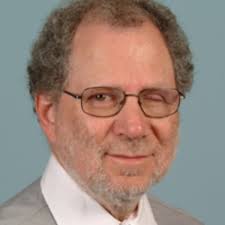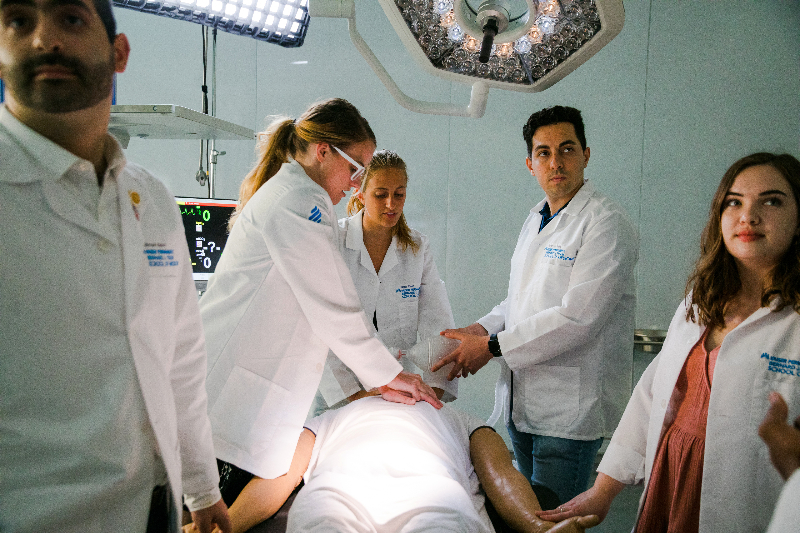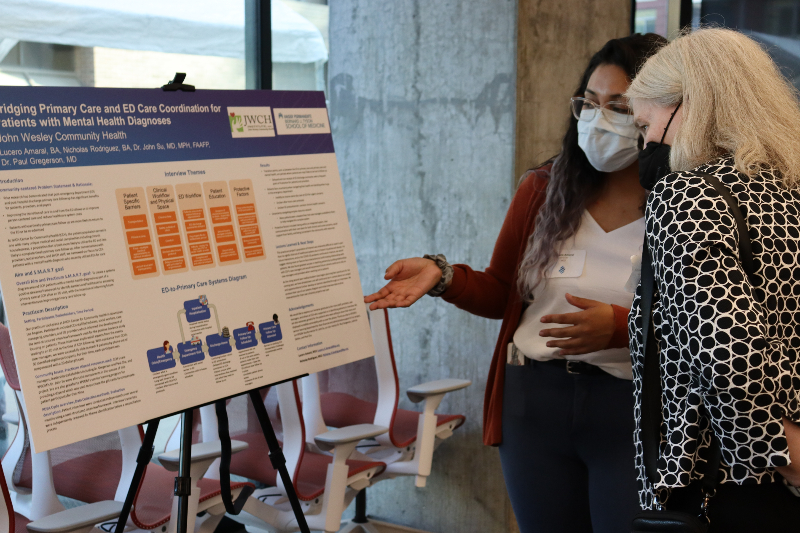Kaiser Permanente Bernard J. Tyson School of Medicine’s Simulation Center provides hands-on experience in a supportive environment.
Inside Perspective: Bruce Blumberg, MD
A Lifetime of Experience to Educate the Next Generation of Doctors
This is a series of first-person pieces from the Permanente physicians on the ground floor of creating the new Kaiser Permanente School of Medicine.
By Bruce Blumberg, MD
Who am I?

Why do we have to start with such a difficult question? I am many things; like everyone, I am complicated. I am a son, a husband, a father of three adult children, a grandfather, a dog-lover, and a retiree (or at least a “retiree”). As essential as is any of my identities, I am a physician. I graduated from Yale Medical School long enough ago that there were 85 men and 7 women in my class (more about this later). I completed my training in pediatrics and medical genetics at Stanford University and the University of California, Los Angeles, concurrently working as a Permanente Medical Group (PMG) pool/per diem physician in both Northern and Southern California beginning in 1976. Upon completing my training, I began my career as a pediatrician and geneticist based at the San Francisco Kaiser Permanente Medical Center in 1981.
My life has paralleled the birth and growth of medical genetics as a specialty. I was born before the double helix was described and before the normal number of human chromosomes was identified. During my genetics fellowship, the first application of DNA technology to medical diagnosis was reported. I remember when it required a single slide to lecture on all of the diseases that were amenable to DNA diagnostics. I even remember slides and lectures! As I was completing my fellowship, the first medical genetics board examination was being written. With the maturation of medical genetics as a specialty, my practice in that field eventually became too busy to allow time for general pediatrics, so my practice became limited to medical genetics until my retirement from The Permanente Medical Group in 2016. Permanente Genetics is organized as a regional/sub-regional service, so my practice spanned 11 Kaiser Permanente medical centers over the course of my career.
One of the underappreciated benefits of a Permanente career is the opportunity for continual self-reinvention. Where else can you have a midlife crisis every 5 to 10 years and completely change your job without having to change your work email address? During my 40-plus years with Permanente, I have been an assistant department chief, a department chief, a chief of Medical-Legal Affairs, a physician-in-chief, a chief-of-staff, a board director, and a chair of Physician Compensation and Benefits. Along with these roles, medical education has been a continuing career thread. In the 1980s, I was honored to twice receive teaching awards from the Pediatric residents at Kaiser Permanente San Francisco. I have remained active in the academic medical community and currently hold appointments as clinical professor of Pediatrics at University of California, San Francisco (UCSF), and University of California, Davis, and as adjunct clinical professor of Pediatrics at Stanford University.
I am a member of the Association of American Medical Colleges Holistic Review Advisory Group, which is charged with promoting the diversity of the national medical school student body. One of the benefits of a long life and career is the opportunity to observe the slow motion of social evolution. My father became a PhD chemist when his desire to attend medical school was thwarted by the overt ethnic admissions quotas that defined the norm of the 1930s. My own medical school class, as I have noted, was far from gender balanced, even in a decade that was marked by the rise of feminism. We have made much progress, but we still have a lot of work in front of us if we are to achieve social justice and health equity. At the national level, efforts to increase the medical school enrollment of African-American men have been largely unsuccessful, and at the state level, California continues to experience a serious shortage of Hispanic physicians (~5 percent of physicians vs. almost 40 percent of the population and >50 percent of newborns).
For the last decade of my Permanente Medical Group career, I was the institutional director of Graduate Medical Education for Kaiser Permanente Northern California. In this role, I was responsible for overseeing the programs that educated and trained over 1,300 residents and 600 medical students annually. Among my proudest accomplishments in that role were overseeing the establishment of Northern California’s first Family Medicine residencies, the creation of a UCSF longitudinal integrated third-year clerkship at Kaiser Permanente Oakland, and the establishment of regional medical campuses for Drexel University (at Kaiser Permanente Sacramento/Roseville, South Sacramento, and Vacaville) and Boston University (at Kaiser Permanente Santa Clara and San Jose). Although I once saw the strategy of partnering with existing medical schools as a course parallel to the creation of an independent medical school, the experience that was gained in the act of partnering is now proving to be invaluable in the work of building a Kaiser Permanente School of Medicine. Immediately upon my retirement from The Permanente Medical Group, I reactivated my status as a Southern California Permanente Medical Group per diem physician (after a nearly 40-year hiatus) to allow me to continue to participate as a Permanente physician in the planning for the Kaiser Permanente School of Medicine. I guess my career has come full circle.
What am I doing for the School of Medicine?
In keeping with the varied nature of my Permanente career, I have been making small contributions to the School in several very different domains. My initial role was as a contributor to the development of the medical school business case that was successfully presented to the Kaiser Foundation Health Plan Board of Directors; my specific area of input was in the diversity and inclusion section of the proposal. Following the board’s approval of funding, I was a member of the design team that provided input as the new medical school building was being envisioned. I was a member of the group that drafted bylaws for the medical school, and my longitudinal knowledge of the Kaiser Permanente environment was very useful in this project. I was a member of the leadership group that initially recruited and selected members of the Curriculum Committee, and I have served as a member of that committee since its launch. My focused involvement has been in the construction of the integrated curriculum of the medical school’s first two years. The curriculum is largely case-based, and the process of case construction is about to enter an active phase. I am the only group member who is a pediatrician, so I will be making an effort to ensure that children’s issues are represented in the curriculum.
We live in an era in which faculty emphasis has shifted from teaching to the facilitation of learning.
I have continued to contribute to the workgroup that is overseeing diversity and inclusion, one of the medical school’s foundational pillars. The group has worked in concert with the Curriculum Committee to ensure that our future graduates will be prepared to be leaders in the field of health equity. The group also has reached into the admissions domain and is preparing an admissions process that will recruit applicants who are a good fit for Kaiser Permanente’s mission and values and who will thrive in the planned curriculum.
Finally (for now), I am the Permanente lead for faculty development. We live in an era in which faculty emphasis has shifted from teaching to the facilitation of learning. Building a school within a high-functioning health care delivery system offers us a wealth of future educators. All our Permanente colleagues are skilled clinicians, and many of these prospective faculty members have experience with the education and training of residents, fellows, and visiting medical students, but none will have previously experienced the innovative curriculum of the Kaiser Permanente School of Medicine. We must ensure that our future faculty possesses the basic and advanced medical education knowledge and skills required for the School’s success. For the small number of experienced faculty members recruited from outside Permanente, it additionally will be necessary to instill the values of Permanente practice and to convey practical knowledge of the Kaiser Permanente universe.
How is it going?
Well, the answer may depend on the “it” in the question. If you were to ask my family, they probably would contend that I am failing at retirement, but I am always at my happiest when I am on the steep part of a learning curve.
First, the good (and the good is great!): I am incredibly impressed by the dedicated group of Kaiser Permanente and PMG colleagues who are simultaneously demonstrating their expertise, their leadership, and their creativity. I must admit that I can’t figure out how they are devoting so much time and energy to this immense project while simultaneously managing their Permanente day jobs. I’m retired, and there are still days when I can’t find enough time to get everything done!
To be fair, the OK: The “imposter syndrome” experienced by many (all?) medical students as they begin their lives in medicine doesn’t ever completely fade away. With each new role I have taken on during my career, I have had moments when I wondered if I had the required attributes and expertise to be successful in the role. My most recent roles are no exception, but my years in the field allow me to take the long view and realize that we are all in the same situation. I’ll bet the dean of every university medical school has the same moments of doubt.
Finally, the good news/bad news: It has been exciting to witness the level of enthusiasm that the School has generated within and beyond the walls of Kaiser Permanente. The School’s current developmental plans are rightly focused on the accreditation process and the establishment of a curricular foundation. In parallel, I and others are focused on accelerating the pace of engagement with those who are interested. Passions thrive when they are offered an opportunity for exercise. (Perhaps this is what is really meant by “exercise as a vital sign.”)
Bruce Blumberg, MD, of Southern California Permanente Medical Group, is a Core Professor, Kaiser Permanente School of Medicine.


